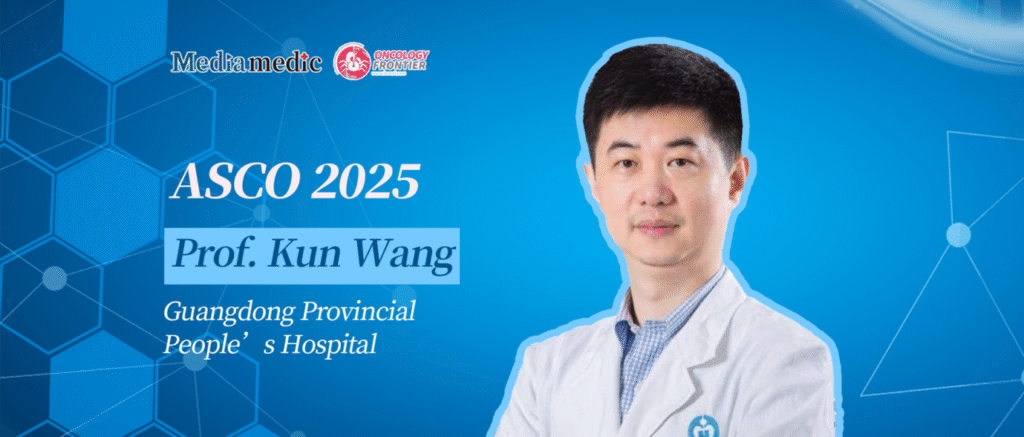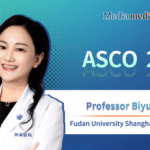
Editor’s Note: The 2025 American Society of Clinical Oncology (ASCO) Annual Meeting took place from May 30 to June 3 in Chicago. At this high-profile event, Professor Kun Wang from Guangdong Provincial People’s Hospital presented the much-anticipated results of the neoCARHP study (Abstract LBA500) during an oral session. The study, which focuses on early-stage HER2-positive breast cancer, offers an innovative head-to-head comparison between a carboplatin-free THP regimen and the traditional carboplatin-containing TCbHP regimen. The findings revealed that the THP regimen was non-inferior to TCbHP in terms of pathological complete response (pCR), with a significantly better toxicity profile. This important discovery not only provides a new therapeutic option for patients with HER2-positive breast cancer but also reflects a patient-centered approach to treatment—marking a shift toward more precise and individualized care. Following the presentation, Oncology Frontier interviewed Professor Wang to discuss the study’s background, significance, and what the future holds for HER2-positive breast cancer treatment.Study Overview
Background Neoadjuvant taxane, carboplatin and trastuzumab plus pertuzumab is associated with excellent treatment outcomes. The neoCARHP study aimed to evaluate the efficacy and safety of a de-escalated neoadjuvant taxane plus trastuzumab and pertuzumab with or without carboplatin in HER2-positive early breast cancer.
Methods The neoCARHP was a multicenter,open-label, randomized non-inferiority phase 3 trial conducted in 15 hospitals. Eligible patients were ≥18 years old with untreated, stage II-III, invasive HER2-positive breast cancer.Patients were stratified by nodal and hormone receptor status and randomized (1:1) to receive six 3-week cycles of an investigator-selected taxane (docetaxel, paclitaxel or nab-paclitaxel) plus trastuzumab (8 mg/kg loading dose, then 6 mg/kg every 3 weeks) and pertuzumab (840 mg loading dose, then 420 mg every 3 weeks), with carboplatin (TCbHP; AUC 6 mg/mL per min) or without carboplatin (THP). The primary endpoint was the pathological complete response (pCR) rate in the breast and axilla (ypT0/is ypN0), assessed in the modified intent-to-treat (mITT) population (all randomised patients who received at least one dose of study medication).
The primary efficacy analysis was performed using the Cochran-Mantel-Haenszel χ2test(stratified by nodal and hormone receptor status), with a prespecified non-inferiority margin of -10%. Assuming a pCR rate of 62.8% for each group, 774 patients would provide 80% power at a one-sided significance level of 0.025, with an assumed 5% dropout rate. Safety was assessed in all patients who received the study drug.
Results
Between April 30, 2021, and August 27, 2024, a total of 774 patients were enrolled and randomized (387 in each arm). Among them, 766 patients were included in the modified intention-to-treat (mITT) population—382 in the THP group and 384 in the TCbHP group.
In the THP group, 245 patients achieved pathological complete response (pCR), yielding a pCR rate of 64.1% (95% CI: 59.2–68.8). In the TCbHP group, 253 patients achieved pCR, corresponding to a rate of 65.9% (95% CI: 61.0–70.5). The absolute difference in pCR rates between the two groups was –1.8% (95% CI: –8.5 to 5.0), with an odds ratio of 0.93 (95% CI: 0.69–1.25; P = 0.0089), demonstrating the non-inferiority of the THP regimen.
In terms of safety, patients in the THP group experienced fewer grade 3–4 adverse events (79 of 382 [20.7%]) compared to those in the TCbHP group (133 of 384 [34.6%]). Serious adverse events were also less frequent in the THP group (5 of 382 [1.3%] vs. 18 of 384 [4.7%]). The most common grade 3–4 adverse events in the THP arm included neutropenia (26 of 382 [6.8%] vs. 63 of 384 [16.4%] in TCbHP), leukopenia (21 [5.5%] vs. 57 [14.8%]), and diarrhea (10 [2.6%] vs. 16 [4.2%]). No treatment-related deaths occurred in either group.
Conclusion
THP provided non-inferior pCR rates and improved tolerability compared with TCbHP. Omitting carboplatin could be an efficacious de-escalated neoadjuvant strategy in the presence of dual HER2 blockade for patients with HER2-positive early breast cancer.
Expert Interview
Oncology Frontier: The neoCARHP study focuses on neoadjuvant therapy for HER2-positive early-stage breast cancer. Could you share the background and motivation for initiating this study? In the context of significant progress in targeted therapies, why explore a “de-escalation” treatment strategy?
Professor Kun Wang: Neoadjuvant therapy has become the standard approach for treating HER2-positive early breast cancer. The currently recommended regimen in clinical practice is TCbHP, which combines a taxane and carboplatin with trastuzumab and pertuzumab. However, in our real-world clinical experience, we’ve observed that some patients struggle to tolerate the adverse effects associated with carboplatin—particularly hematologic and gastrointestinal toxicities.
This led us to consider whether, on the foundation of the already effective standard regimen, it might be possible to achieve comparable efficacy by reducing the use of platinum agents. Our thinking was inspired in part by previous studies, such as the BCIRG-007 trial in advanced HER2-positive breast cancer. That study showed that the addition of carboplatin to docetaxel and trastuzumab did not significantly improve outcomes compared to docetaxel and trastuzumab alone.
Those earlier findings provided a strong rationale for conducting a non-inferiority trial like neoCARHP. Our goal was to evaluate whether a carboplatin-free regimen—consisting of a taxane combined with trastuzumab and pertuzumab—could deliver efficacy and safety outcomes similar to the standard TCbHP regimen, while improving tolerability.
Oncology Frontier: As a large phase III trial led by Chinese investigators, what impact do you believe the results of the neoCARHP study will have on the broader treatment landscape for HER2-positive breast cancer?
Professor Kun Wang: At this year’s ASCO meeting, we received congratulations from many colleagues both in China and abroad. There was a shared sense of recognition that the findings from the neoCARHP study could significantly influence clinical practice for early-stage HER2-positive breast cancer.
Currently, the TCbHP regimen is the standard neoadjuvant treatment for this patient population. It delivers an impressive pathological complete response (pCR) rate of around 60%, which is considered highly effective. However, in the neoCARHP trial, we conducted a direct head-to-head comparison between the carboplatin-free THP regimen and the standard TCbHP regimen. Our results showed a pCR rate of 64.1% in the THP group versus 65.9% in the TCbHP group—an absolute difference of just 1.8%. More importantly, this difference met the pre-defined criteria for non-inferiority, with a P-value of 0.0089, which is statistically significant.
What this means is that by removing one drug—carboplatin—we can meaningfully reduce toxicity without compromising efficacy. In fact, we may even improve the treatment experience. This is a highly valuable discovery and has been widely praised. The study underscores that strategic de-escalation, when done on a solid scientific foundation, can lead to better patient-centered outcomes in clinical practice.
Oncology Frontier: The neoCARHP study provides strong evidence in support of a de-escalation strategy. Looking ahead, what other areas of HER2-positive breast cancer neoadjuvant therapy do you think warrant further exploration?
Professor Kun Wang: There are several promising directions we’re eager to explore in the treatment of HER2-positive breast cancer. First, we aim to use biomarkers to better identify which patients are most likely to benefit from neoadjuvant therapy. This would allow us to tailor treatments more precisely and enhance their effectiveness.
Second, radiomics and translational research could offer new insights into therapeutic strategies and outcomes. These advanced tools can help us better understand disease biology and treatment response mechanisms on a deeper level.
Finally, with the rapid development of novel antibody-drug conjugates (ADCs), we are looking forward to exploring chemotherapy-free neoadjuvant regimens. These innovative agents may offer improved efficacy while reducing treatment burden and side effects for patients. Altogether, these areas are full of potential and merit further research and clinical investigation.

Guangdong Provincial People’s Hospital


